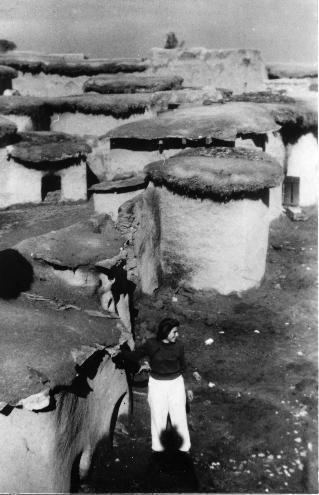Arabic هوج Area 21,988 dunams22.9 km² | Also spelled al-Hug Palestine grid 114/102 Local time Thursday 9:24 AM Date of depopulation 31 May 1948 | |
 | ||
Name meaning Possibly named after the prophet Og Weather 16°C, Wind SW at 11 km/h, 64% Humidity | ||
Huj (Arabic: هوج) was a Palestinian Arab village located 15 kilometers (9.3 mi) northeast of Gaza City. Identified as the site of the ancient Philistine town of Oga, the modern village was founded by the Ottomans in the early 19th century.
Contents
Situated in a hilly area on the northern edge of the Negev Desert, it was depopulated during the 1948 Arab-Israeli War.
History
Identified with the Philistine town of Oga, it is notable for being depicted on the 6th century Map of Madaba.
Ottoman era
The modern village of Huj was established sometime between 1818 and 1820 by Mustafa Bey, the Ottoman Governor of Gaza and Jaffa. He built a police station to keep the village secure, and offered free land to encourage migration to the site from Gaza from amongst the surrounding Bedouin tribes. Huj and its greater vicinity were dominated by the tribes of Jebarat and Wahaideh, the latter of which participated in the 1834 rebellion against Egyptian rule. The rebellion was suppressed and most the Wahaideh were killed, imprisoned, or forced to work the lands, while the rest fled the area. In 1838, Edward Robinson noted that its houses were built of adobe and that the population ranged from 200 to 300, most of whom made a living through grain cultivation and bread making.
In 1863 the French explorer Victor Guérin visited the village. He described as a village of at most three hundred people. The houses were roughly built with mud bricks. Near the well, which was very deep, were a few fragments of ancient columns of gray-white marble lying on the ground.
An Ottoman village list from about 1870 found that Huj had a population of 153, in 63 houses, though the population count included men, only.
In 1883, the Palestine Exploration Fund's Survey of Western Palestine described it as a "small mud village on flat ground. It has a well some 200 feet deep. It is named from Nebi Huj".
British mandate era
Huj witnessed battles between Ottoman and British forces known as the Charge at Huj in 1917. Following Great Britain's victory and the establishment of the British Mandate in Palestine, Huj expanded eastward and to the west. Water was provided by a 200-foot-deep (61 m) well, and by other wells in surrounding riverbeds. The inhabitants cultivated grains, apricots, figs, grapes, and almonds.
In the 1922 census of Palestine, conducted by the British Mandate authorities, Huj had a population of 426 inhabitants, all Muslims, increasing in the 1931 census to 618, still all Muslims, in 118 houses.
In 1945 the population of Huj was counted with that of the nearby Jewish kibbutz Dorot, together they had a population of 810 Muslims and 230 Jews, with a total of 21,988 dunams of land, according to an official land and population survey. Of this, Arabs used 93 dunams for plantations and irrigable land, 16,236 for cereals, while they had 34 dunams as built-up land.
Huj was a village with traditions of friendship with Jews: in 1946, men from the Haganah, being pursued in a crackdown by the British army, were given sanctuary by its inhabitants. Only after the passage of the United Nations Partition Plan for Palestine in late November 1947 did relations sour and the mukhtar and his brother were shot on the charge that they were collaborators.
1948 war and aftermath
As the Egyptian army advanced from the south a decision was taken towards the end of May 1948 by the Negev Brigade to expel the villagers of Huj from their lands, and on 31 May, their houses were blown up, their assets looted, and they were driven off to the Gaza Strip. The heads of three kibbutzim, respectively Farda, Gavri and Frisch from Dorot, Nir-Am and Ruhama, later, on August 4, wrote a letter of complaint to Ben-Gurion over the treatment that had been meted out to the local Palestinians. While personally he did not intervene and did not condemn what had happened, he expressed a hope that the IDF might listen to their complaint:
"I hope that the HQ will pay attention to what you say, and will avoid such unjust and unjustified actions in the future, and will set right these things in so far as possible with respect to the past."
In September 1948 former villagers of Huj, noting that the area around Huj was quiet, appealed to Israel to allow them back. Members of the "Department of Minority Affairs" (Shitrit and Shimoni) wrote that the inhabitants deserved special treatment as they had been "loyal", and had not fled but were expelled. However, the Israeli defence authorities decided not to allow the villagers back.
In 1998, refugees from Huj in Gaza numbered an estimated 5,770 people.
